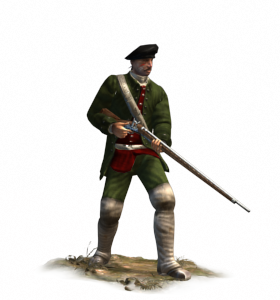Difference between revisions of "Rangers (ETW Unit)"
(→Details) |
(→Details) |
||
| Line 28: | Line 28: | ||
Available at the beginning of the game in the North America to the colonial powers and the Thirteen Colonies, Rangers are irregular skirmishers. Unlike most light infantry, Rangers do not require Light Infantry Doctrine to recruit, and they are accessible in unlimited number as long as the training facilities are available. This makes rangers early substitutes for [[Light Infantry (ETW Unit)|Light Infantry]]. Like Light Infantry, they have superior range to [[Line Infantry (ETW Unit)|Line Infantry]], can deploy skirmishing tactics, and are invisible to the enemy when immobile; by default, rangers also are in a scattered formation, making them more resistance to massed fire although it increases their vulnerability to cavalry. Statistically, rangers are superior to light infantry in terms of melee capabilities but inferior in terms of accuracy and reloading skill, making them more useful against nations that favor melee infantry such as the Native Americans and the Maratha Confederacy. | Available at the beginning of the game in the North America to the colonial powers and the Thirteen Colonies, Rangers are irregular skirmishers. Unlike most light infantry, Rangers do not require Light Infantry Doctrine to recruit, and they are accessible in unlimited number as long as the training facilities are available. This makes rangers early substitutes for [[Light Infantry (ETW Unit)|Light Infantry]]. Like Light Infantry, they have superior range to [[Line Infantry (ETW Unit)|Line Infantry]], can deploy skirmishing tactics, and are invisible to the enemy when immobile; by default, rangers also are in a scattered formation, making them more resistance to massed fire although it increases their vulnerability to cavalry. Statistically, rangers are superior to light infantry in terms of melee capabilities but inferior in terms of accuracy and reloading skill, making them more useful against nations that favor melee infantry such as the Native Americans and the Maratha Confederacy. | ||
| + | |||
| + | Unlike light infantry, rangers do not have the ability to deploy stakes. They do not initially have the ability to toggle light infantry behavior, although this option becomes available with research. | ||
==Factions== | ==Factions== | ||
Revision as of 08:08, 26 March 2013
 These Light Infantrymen are trained in wilderness warfare and taught to survive in harsh conditions.
These Light Infantrymen are trained in wilderness warfare and taught to survive in harsh conditions.
Overview
Rangers are used for scouting and raiding missions far beyond the skills of ordinary men. Their ranks are mostly drawn from frontiersmen already hardened to living in the wilderness, as their experience making them ideal for further training. The wild nature of their environment is reflected in the unconventional tactics they are taught, and they are given some leeway where formal army discipline is concerned.
Historically, rangers were employed by the British army and were used in the hostile environments of North America during the French and Indian War. They would carry out long distance winter raids using crude snowshoes to travel. The most famous and revered of all rangers were the “Rogers’ Rangers”, named for their commanding officer, Robert Rogers. The traditions of Rogers’ Rangers are carried on today by the US Army Rangers.
Details
Available at the beginning of the game in the North America to the colonial powers and the Thirteen Colonies, Rangers are irregular skirmishers. Unlike most light infantry, Rangers do not require Light Infantry Doctrine to recruit, and they are accessible in unlimited number as long as the training facilities are available. This makes rangers early substitutes for Light Infantry. Like Light Infantry, they have superior range to Line Infantry, can deploy skirmishing tactics, and are invisible to the enemy when immobile; by default, rangers also are in a scattered formation, making them more resistance to massed fire although it increases their vulnerability to cavalry. Statistically, rangers are superior to light infantry in terms of melee capabilities but inferior in terms of accuracy and reloading skill, making them more useful against nations that favor melee infantry such as the Native Americans and the Maratha Confederacy.
Unlike light infantry, rangers do not have the ability to deploy stakes. They do not initially have the ability to toggle light infantry behavior, although this option becomes available with research.
